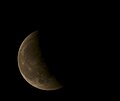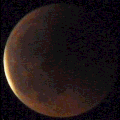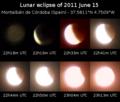| Total eclipse | |||||||||||||||||
 Totality as viewed from Dar es Salaam, Tanzania, 19:28 UTC Totality as viewed from Dar es Salaam, Tanzania, 19:28 UTC | |||||||||||||||||
| Date | June 15, 2011 | ||||||||||||||||
|---|---|---|---|---|---|---|---|---|---|---|---|---|---|---|---|---|---|
| Gamma | 0.0897 | ||||||||||||||||
| Magnitude | 1.7014 | ||||||||||||||||
| Saros cycle | 130 (34 of 72) | ||||||||||||||||
| Totality | 100 minutes, 13 seconds | ||||||||||||||||
| Partiality | 219 minutes, 17 seconds | ||||||||||||||||
| Penumbral | 336 minutes, 4 seconds | ||||||||||||||||
| |||||||||||||||||
| ← December 2010December 2011 → | |||||||||||||||||
A total lunar eclipse occurred at the Moon’s ascending node of orbit on Wednesday, June 15, 2011, with an umbral magnitude of 1.7014. A lunar eclipse occurs when the Moon moves into the Earth's shadow, causing the Moon to be darkened. A total lunar eclipse occurs when the Moon's near side entirely passes into the Earth's umbral shadow. Unlike a solar eclipse, which can only be viewed from a relatively small area of the world, a lunar eclipse may be viewed from anywhere on the night side of Earth. A total lunar eclipse can last up to nearly two hours, while a total solar eclipse lasts only a few minutes at any given place, because the Moon's shadow is smaller. Occurring about 4.1 days after perigee (on June 11, 2011, at 21:40 UTC), the Moon's apparent diameter was larger.
This was a relatively rare central lunar eclipse, where the Moon crossed the center of the Earth's shadow. The last time a lunar eclipse was closer to the center of the Earth's shadow was on July 16, 2000. The next central total lunar eclipse occurred on July 27, 2018.
Visibility and viewing
The eclipse was completely visible over east Africa, Antarctica, and west, central, and south Asia, seen rising over Europe, west Africa, and South America and setting over east Asia and Australia.
In western Asia, Australia, and the Philippines, the lunar eclipse was visible just before sunrise. It was very visible in the clear and cloudless night sky throughout eastern and southeast Asia. Africa, far eastern Russia and Europe witnessed the whole event even in the late stages (as in partial lunar eclipse). The Americas (including North and northwestern South America) missed the eclipse completely (except in most areas) because it occurred at moonset.

|
 Hourly motion shown right to left |
 The Moon's hourly motion across the Earth's shadow in the constellation of Ophiuchus (north of Scorpius). |
 Visibility map | ||
Images

Gallery
-
 Macau, 18:43 UTC
Macau, 18:43 UTC
-
 Hong Kong, 18:47 UTC
Hong Kong, 18:47 UTC
-
 Vittoriosa, Malta, 18:52 UTC
Vittoriosa, Malta, 18:52 UTC
-
 Makati, Philippines, 19:21 UTC
Makati, Philippines, 19:21 UTC
-
 Mangalore, India, 19:32 UTC
Mangalore, India, 19:32 UTC
-
 Dompu, Indonesia, 19:35 UTC
Dompu, Indonesia, 19:35 UTC
-
 Sofia, Bulgaria, 19:42 UTC
Sofia, Bulgaria, 19:42 UTC
-
 Tehran, Iran, 19:44 UTC
Tehran, Iran, 19:44 UTC
-
 Abu Dhabi, U.A.E., 19:53 UTC
Abu Dhabi, U.A.E., 19:53 UTC
-
 Johannesburg, South Africa, 22:03 UTC
Johannesburg, South Africa, 22:03 UTC
-
 Marseille, France, 20:07 UTC
Marseille, France, 20:07 UTC
-
 Slovenska Bistrica, Slovenia, 20:58 UTC
Slovenska Bistrica, Slovenia, 20:58 UTC
-
 Deva, Romania, 21:01 UTC
Deva, Romania, 21:01 UTC
-
 Palermo, Italy, 21:04 UTC
Palermo, Italy, 21:04 UTC
-
 Perth, Australia, ~21:10 UTC
Perth, Australia, ~21:10 UTC
-
 Germering, Germany, 21:22 UTC
Germering, Germany, 21:22 UTC
-
 Salto, São Paulo, 21:23 UTC
Salto, São Paulo, 21:23 UTC
-
 Lisbon, Portugal, 21:35 UTC
Lisbon, Portugal, 21:35 UTC
-
 Bærum, Norway, 21:37 UTC
Bærum, Norway, 21:37 UTC
-
 Tbilisi, Georgia, 21:45 UTC
Tbilisi, Georgia, 21:45 UTC
-
 Budapest, Hungary, 21:50 UTC
Budapest, Hungary, 21:50 UTC
-
 Vienna, Austria
Vienna, Austria
-
 Sobotin, Czech republic
Sobotin, Czech republic
-
 Animation from Pagny-le-Château, France
Animation from Pagny-le-Château, France
-
 Athens, Greece
Athens, Greece
-
 Animation from Novosibirsk, Russia
Animation from Novosibirsk, Russia
-
 Córdoba, Spain
Córdoba, Spain
Eclipse details
Shown below is a table displaying details about this particular solar eclipse. It describes various parameters pertaining to this eclipse.
| Parameter | Value |
|---|---|
| Penumbral Magnitude | 2.68833 |
| Umbral Magnitude | 1.70136 |
| Gamma | 0.08968 |
| Sun Right Ascension | 05h35m33.6s |
| Sun Declination | +23°19'06.1" |
| Sun Semi-Diameter | 15'44.7" |
| Sun Equatorial Horizontal Parallax | 08.7" |
| Moon Right Ascension | 17h35m32.3s |
| Moon Declination | -23°13'51.6" |
| Moon Semi-Diameter | 15'57.2" |
| Moon Equatorial Horizontal Parallax | 0°58'33.0" |
| ΔT | 66.5 s |
Eclipse season
See also: Eclipse cycleThis eclipse is part of an eclipse season, a period, roughly every six months, when eclipses occur. Only two (or occasionally three) eclipse seasons occur each year, and each season lasts about 35 days and repeats just short of six months (173 days) later; thus two full eclipse seasons always occur each year. Either two or three eclipses happen each eclipse season. In the sequence below, each eclipse is separated by a fortnight. The first and last eclipse in this sequence is separated by one synodic month.
| June 1 Descending node (new moon) |
June 15 Ascending node (full moon) |
July 1 Descending node (new moon) |
|---|---|---|
 |
 |

|
| Partial solar eclipse Solar Saros 118 |
Total lunar eclipse Lunar Saros 130 |
Partial solar eclipse Solar Saros 156 |
Related eclipses
Eclipses in 2011
- A partial solar eclipse on January 4.
- A partial solar eclipse on June 1.
- A total lunar eclipse on June 15.
- A partial solar eclipse on July 1.
- A partial solar eclipse on November 25.
- A total lunar eclipse on December 10.
Metonic
- Preceded by: Lunar eclipse of August 28, 2007
- Followed by: Lunar eclipse of April 4, 2015
Tzolkinex
- Preceded by: Lunar eclipse of May 4, 2004
- Followed by: Lunar eclipse of July 27, 2018
Half-Saros
- Preceded by: Solar eclipse of June 10, 2002
- Followed by: Solar eclipse of June 21, 2020
Tritos
- Preceded by: Lunar eclipse of July 16, 2000
- Followed by: Lunar eclipse of May 16, 2022
Lunar Saros 130
- Preceded by: Lunar eclipse of June 4, 1993
- Followed by: Lunar eclipse of June 26, 2029
Inex
- Preceded by: Lunar eclipse of July 6, 1982
- Followed by: Lunar eclipse of May 26, 2040
Triad
- Preceded by: Lunar eclipse of August 14, 1924
- Followed by: Lunar eclipse of April 15, 2098
Lunar eclipses of 2009–2013
This eclipse is the center of nine lunar eclipses in a short-lived series. Each eclipse in the series repeats after one semester (6 lunations or 177 days) occurring at alternating nodes.
| Lunar eclipse series sets from 2009–2013 | ||||||||
|---|---|---|---|---|---|---|---|---|
| Ascending node | Descending node | |||||||
| Saros # Photo |
Date Viewing |
Type chart |
Gamma | Saros # Photo |
Date Viewing |
Type chart |
Gamma | |
| 110 | 2009 Jul 07
|
penumbral
|
−1.4916 | 115
|
2009 Dec 31
|
partial
|
0.9766 | |
120
|
2010 Jun 26
|
partial
|
−0.7091 | 125
|
2010 Dec 21
|
total
|
0.3214 | |
130
|
2011 Jun 15
|
total
|
0.0897 | 135
|
2011 Dec 10
|
total
|
−0.3882 | |
140
|
2012 Jun 04
|
partial
|
0.8248 | 145 | 2012 Nov 28
|
penumbral
|
−1.0869 | |
| 150 | 2013 May 25
|
penumbral
|
1.5351 | |||||
| Last set | 2009 Aug 06 | Last set | 2009 Feb 9 | |||||
| Next set | 2013 Apr 25 | Next set | 2013 Oct 18 | |||||
Saros 130
Lunar saros series 130, repeating every 18 years and 11 days, has a total of 71 lunar eclipse events including 56 umbral lunar eclipses (42 partial lunar eclipses and 14 total lunar eclipses). Solar Saros 137 interleaves with this lunar saros with an event occurring every 9 years 5 days alternating between each saros series.
| Greatest | First | |||
|---|---|---|---|---|
 The greatest eclipse of the series will occur on 2029 Jun 26, lasting 102 minutes. |
Penumbral | Partial | Total | Central |
| 1416 Jun 10 | 1560 Sep 4 | 1921 Apr 22
|
1957 May 13
| |
| Last | ||||
| Central | Total | Partial | Penumbral | |
2083 Jul 29
|
2155 Sep 11 | 2552 May 10 | 2678 Jul 26 | |
| 1903 Apr 12 | 1921 Apr 22 | 1939 May 3 | |||

|

|

|

|

|

|
| 1957 May 13 | 1975 May 25 | 1993 Jun 4 | |||

|

|

|

|

|

|
| 2011 Jun 15 | 2029 Jun 26 | 2047 Jul 7 | |||

|

|

|

|

|

|
| 2065 Jul 17 | 2083 Jul 29 | ||||

|

|

|

| ||
Tritos series
The tritos series repeats 31 days short of 11 years at alternating nodes. Sequential events have incremental Saros cycle indices.
This series produces 23 total eclipses between June 22, 1880 and August 9, 2120.
| Ascending node | Descending node | |||||
|---|---|---|---|---|---|---|
| Saros | Date Viewing |
Type chart |
Saros | Date Viewing |
Type chart | |
| 120 | 1902 Apr 22
|
Total
|
121 | 1913 Mar 22
|
Total
| |
| 122 | 1924 Feb 20
|
Total
|
123 | 1935 Jan 19
|
Total
| |
| 124 | 1945 Dec 19
|
Total
|
125 | 1956 Nov 18
|
Total
| |
| 126 | 1967 Oct 18
|
Total
|
127 | 1978 Sep 16
|
Total
| |
| 128 | 1989 Aug 17
|
Total
|
129 | 2000 Jul 16
|
Total
| |
| 130 | 2011 Jun 15
|
Total
|
131 | 2022 May 16
|
Total
| |
| 132 | 2033 Apr 14
|
Total
|
133 | 2044 Mar 13
|
Total
| |
| 134 | 2055 Feb 11
|
Total
|
135 | 2066 Jan 11
|
Total
| |
| 136 | 2076 Dec 10
|
Total
|
137 | 2087 Nov 10
|
Total
| |
| 138 | 2098 Oct 10
|
Total
| ||||
Inex series
The inex series repeats eclipses 20 days short of 29 years, repeating on average every 10571.95 days. This period is equal to 358 lunations (synodic months) and 388.5 draconic months. Saros series increment by one on successive Inex events and repeat at alternate ascending and descending lunar nodes.
This period is 383.6734 anomalistic months (the period of the Moon's elliptical orbital precession). Despite the average 0.05 time-of-day shift between subsequent events, the variation of the Moon in its elliptical orbit at each event causes the actual eclipse time to vary significantly. It is a part of Lunar Inex series 39.
All events in this series listed below and more are total lunar eclipses.
| Ascending node | Descending node | Ascending node | Descending node | ||||
|---|---|---|---|---|---|---|---|
| Saros | Date | Saros | Date | Saros | Date | Saros | Date |
| 96 | 1027 Apr 23 | 97 | 1056 Apr 2 | 98 | 1085 Mar 14 | 99 | 1114 Feb 21 |
| 100 | 1143 Feb 1 | 101 | 1172 Jan 13 | 102 | 1200 Dec 22 | 103 | 1229 Dec 2 |
| 104 | 1258 Nov 12 | 105 | 1287 Oct 22 | 106 | 1316 Oct 2 | 107 | 1345 Sep 12 |
| 108 | 1374 Aug 22 | 109 | 1403 Aug 2 | 110 | 1432 Jul 13 | 111 | 1461 Jun 22 |
| 112 | 1490 Jun 2 | 113 | 1519 May 14 | 114 | 1548 Apr 22 | 115 | 1577 Apr 2 |
| 116 | 1606 Mar 24 | 117 | 1635 Mar 3 | 118 | 1664 Feb 11 | 119 | 1693 Jan 22 |
| 120 | 1722 Jan 2 | 121 | 1750 Dec 13 | 122 | 1779 Nov 23 | 123 | 1808 Nov 3 |
| 124 | 1837 Oct 13 | 125 | 1866 Sep 24 | 126 | 1895 Sep 4 | 127 | 1924 Aug 14 |
| 128 | 1953 Jul 26
|
129 | 1982 Jul 6
|
130 | 2011 Jun 15
|
131 | 2040 May 26
|
| 132 | 2069 May 6
|
133 | 2098 Apr 15
|
134 | 2127 Mar 28 | 135 | 2156 Mar 7 |
| 136 | 2185 Feb 14 | 137 | 2214 Jan 27 | 138 | 2243 Jan 7 | 139 | 2271 Dec 17 |
| 140 | 2300 Nov 27 | 141 | 2329 Nov 7 | 142 | 2358 Oct 18 | 143 | 2387 Sep 28 |
| 144 | 2416 Sep 7 | 145 | 2445 Aug 17 | 146 | 2474 Jul 29 | ||
Half-Saros cycle
A lunar eclipse will be preceded and followed by solar eclipses by 9 years and 5.5 days (a half saros). This lunar eclipse is related to two annular solar eclipses of Solar Saros 137.
| June 10, 2002 | June 21, 2020 |
|---|---|

|

|
See also
- List of lunar eclipses and List of 21st-century lunar eclipses
- December 2010 lunar eclipse
- December 2011 lunar eclipse
- File:2011-06-15 Lunar Eclipse Sketch.gif Chart
- Solar eclipse
Notes
- "June 15–16, 2011 Total Lunar Eclipse (Blood Moon)". timeanddate. Retrieved 15 November 2024.
- "Moon Distances for London, United Kingdom, England". timeanddate. Retrieved 15 November 2024.
- "Total Lunar Eclipse of 2011 Jun 15" (PDF). NASA. Retrieved 15 November 2024.
- "Longest lunar eclipse for a decade turns moon blood red", Terry Brown. Clare Peddie. Herald Sun. 16 June 2011. Accessed 15 June 2011
- "Total Lunar Eclipse of 2011 Jun 15". EclipseWise.com. Retrieved 15 November 2024.
- Listing of Eclipses of cycle 130
- Mathematical Astronomy Morsels, Jean Meeus, p.110, Chapter 18, The half-saros
References
- Bao-Lin Liu, Canon of Lunar Eclipses 1500 B.C.-A.D. 3000, 1992
External links
- Live-webcast of the lunar eclipse on 15 June 2011, University of Applied Sciences Offenburg/Germany
- Live Free Lunar eclipse webcast & hands-on lunar eclipse experiments: 2011-06-15 Archived 29 June 2011 at the Wayback Machine
- Live eclipse webcasts, Ciclope group/Technical University of Madrid
- Live eclipse webcasts, Sky Watchers Association of North Bengal
- Hermit eclipse: 2011-06-15
- NASA: Lunar Eclipses: Past and Future
- Live webcast by Tübitak Archived 28 August 2011 at the Wayback Machine – the Turkish National Observatory
- Live webcast from the SLOOH Space Camera and Google Earth. The eclipse stages are also being incorporated into a Google doodle operating during the eclipse.
- Webcast
- The Central Lunar Eclipse was shown live through WEBCAST – By Sky Watchers Association of North Bengal(SWAN) Siliguri, West Bengal or
- By Eclipse Chaser Athaenium New Delhi
- By Astronation.net Archived 16 June 2011 at the Wayback Machine
- By Ciclope group and Shelios


